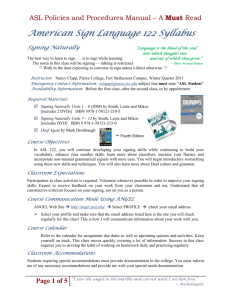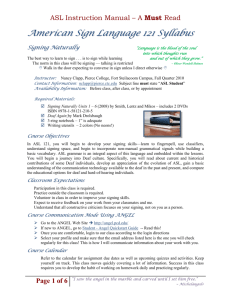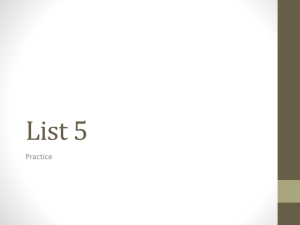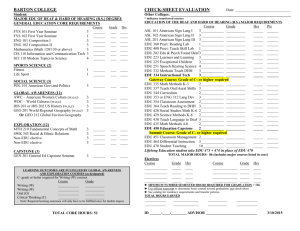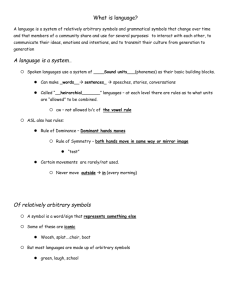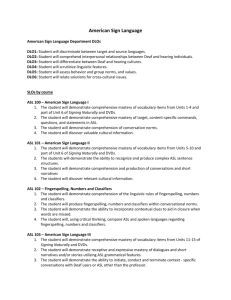ASL 122 Training Guide - Walla Walla Community College
advertisement
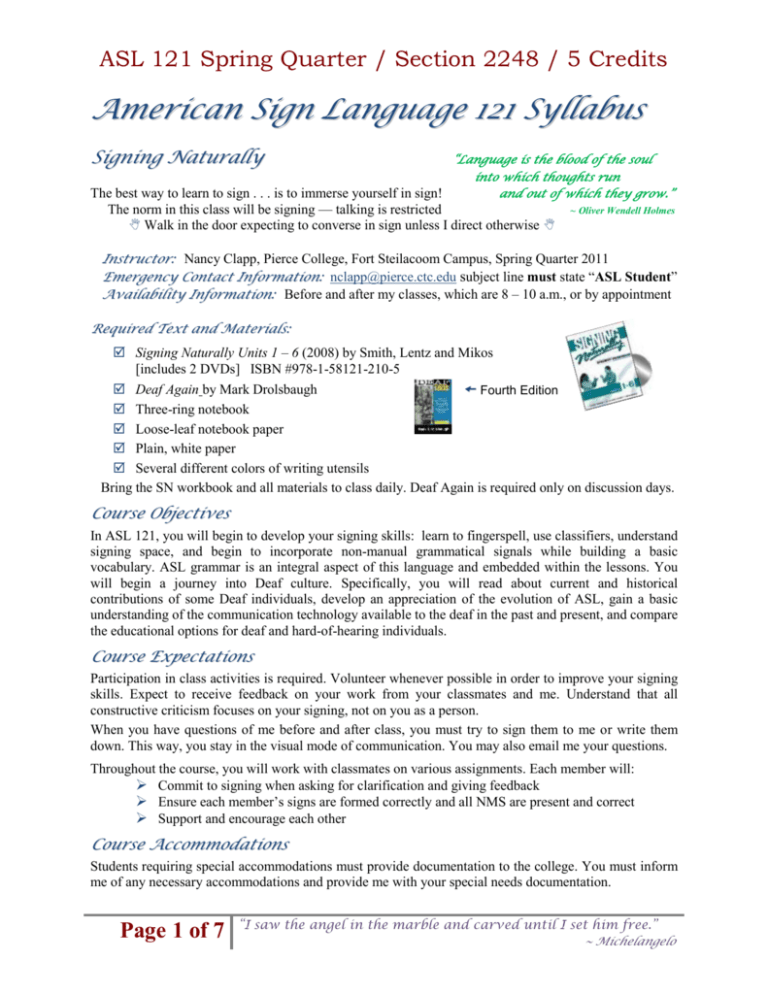
ASL 121 Spring Quarter / Section 2248 / 5 Credits American Sign Language 121 Syllabus Signing Naturally “Language is the blood of the soul into which thoughts run The best way to learn to sign . . . is to immerse yourself in sign! and out of which they grow.” The norm in this class will be signing — talking is restricted Walk in the door expecting to converse in sign unless I direct otherwise ~ Oliver Wendell Holmes Instructor: Nancy Clapp, Pierce College, Fort Steilacoom Campus, Spring Quarter 2011 Emergency Contact Information: nclapp@pierce.ctc.edu subject line must state “ASL Student” Availability Information: Before and after my classes, which are 8 – 10 a.m., or by appointment Required Text and Materials: Signing Naturally Units 1 – 6 (2008) by Smith, Lentz and Mikos [includes 2 DVDs] ISBN #978-1-58121-210-5 Deaf Again by Mark Drolsbaugh Fourth Edition Three-ring notebook Loose-leaf notebook paper Plain, white paper Several different colors of writing utensils Bring the SN workbook and all materials to class daily. Deaf Again is required only on discussion days. Course Objectives In ASL 121, you will begin to develop your signing skills: learn to fingerspell, use classifiers, understand signing space, and begin to incorporate non-manual grammatical signals while building a basic vocabulary. ASL grammar is an integral aspect of this language and embedded within the lessons. You will begin a journey into Deaf culture. Specifically, you will read about current and historical contributions of some Deaf individuals, develop an appreciation of the evolution of ASL, gain a basic understanding of the communication technology available to the deaf in the past and present, and compare the educational options for deaf and hard-of-hearing individuals. Course Expectations Participation in class activities is required. Volunteer whenever possible in order to improve your signing skills. Expect to receive feedback on your work from your classmates and me. Understand that all constructive criticism focuses on your signing, not on you as a person. When you have questions of me before and after class, you must try to sign them to me or write them down. This way, you stay in the visual mode of communication. You may also email me your questions. Throughout the course, you will work with classmates on various assignments. Each member will: Commit to signing when asking for clarification and giving feedback Ensure each member’s signs are formed correctly and all NMS are present and correct Support and encourage each other Course Accommodations Students requiring special accommodations must provide documentation to the college. You must inform me of any necessary accommodations and provide me with your special needs documentation. Page 1 of 7 “I saw the angel in the marble and carved until I set him free.” ~ Michelangelo ASL 121 Spring Quarter / Section 2248 / 5 Credits Course Communication Modes ANGEL Web Site http://angel.pcd.edu/ Select PROFILE check your email address Select your profile and make sure that the email address listed here is the one you will check regularly for this class! This is how I will communicate information about your work with you. You are welcome to access all the features contained within all the tabs in ANGEL but these are the tabs I will be using in this class: Lessons Tab – this is where I will post class-related documents Communication Tab – this is where you will find ANGEL email. My Pierce College email is reserved for emergency contact only. Facebook Account: Log in to Facebook account Request ASL PierceCollege friendship You will create signed videos and post them on our class Facebook account for me to assess. Log in to your Facebook account then request friendship from ASL PierceCollege (select the site with the photo shown here) If you do not wish this to be linked to your personal Facebook account, follow these steps: Create a fake gmail, hotmail, yahoo, or other email account Create a fake Facebook account using the above email account Request friendship from ASL Pierce College If your name and photo will not let me know who you are, please add a message to your request so I will know it is you. I do not allow anyone outside of our class to join this group since you will be posting your signed videos and I respect your right to privacy. Facebook Account: Login to FB Request Pierce College American Sign Language friendship This site provides a list of Deaf events that you can choose to attend. Log in to your Facebook account and type Pierce College American Sign Language in the search bar. Select the site with the photo shown here. You are required to attend at least one Deaf Coffee House, Deaf immersion dinner, or other event that provides opportunities for you to interact in sign language with deaf and hard-ofhearing individuals. While you are welcome to attend a play or other performance-type event, these do not count toward your required assignment because you might not have opportunities to observe and participate in naturally occurring signed conversations. Do not procrastinate in attending one of these. You may find that one is not occurring during the final weeks of the class and you will miss out on this opportunity and on the chance to earn points for this assignment. Course Calendar Refer to the calendar for assignment due dates as well as upcoming quizzes and activities. Keep yourself on track. This class moves quickly covering a lot of information. Success in this class requires you to develop the habit of working on homework daily and practicing regularly. You are responsible for your own learning. I encourage you to exchange contact information with several of your classmates so that should you miss a class, they can tell you Plan for Success what you missed. Do not come to me for that information. I usually make announcements about upcoming events, homework assignments, changes in the schedule, and other relevant information at the beginning or end of class. Page 2 of 7 “I saw the angel in the marble and carved until I set him free.” ~ Michelangelo ASL 121 Spring Quarter / Section 2248 / 5 Credits Classroom Participation Please arrive to class on time prepared to learn. Arriving late causes a visual disruption for those who are on time and already using their eyes to learn. Be courteous. Arrive a few minutes early to settle, prepare mentally for learning, and begin communicating in sign with your peers. If you must voice with a classmate, go out in the hallway where you will not disrupt others. Whispering is never allowed! While you may think you are helping your classmates to better understand the material, you are actually crippling their ability to learn this language. Only by visually and mentally processing signing on their own, will they grasp its meaning. ASL is an interactive language that you can fully learn only by practicing with others and by participating in class activities. If you miss a class, you are responsible for getting missed classwork and newly introduced vocabulary from your classmates. Classroom activities are vital for becoming more comfortable communicating with your hands, face and body. Class attendance is essential for success when learning any foreign language. We discuss and practice a considerable amount of material during class that is not present in the textbook or handouts. Absences hinder your learning and the learning of your team members, so plan to attend every class. I reserve the right to lower your grade to reflect attendance deficits. Cell phones are not allowed in class! If you have a family emergency, let me know before class and you may leave your phone set to vibrate. Do not answer your cell phone or text in class! Please wait until you are in the hallway to respond to the call. Vocabulary Practice You will learn the vocabulary from SN units 1 – 4. You must print the vocabulary sheets and keep in your notebook at all times. You should practice these at the beginning of each unit. Sign with the models in order to develop muscle memory. Sources for vocabulary: http://www.pierce.ctc.edu/staff/jstarr/files/ User name: ____ Password: _________ Signing Naturally DVD VR (vocabulary review) – located at the end of each unit Signing Naturally DVDs – throughout the lessons and stories Facebook ASL PierceCollege account Study Groups You must practice at least 30 minutes of voice-off signing two times each week with a class study group consisting of three to five class members total. All talking should take place before and after this 30minute segment. Prior to each practice session, write down at least one goal you will work toward during that time. These sessions should focus on practicing what we learned in class that week. While vocabulary is important, I strongly suggest you practice signing sentences that incorporate the new vocabulary as well as practice signing classifiers, numbers, grammatical topic/comment structure sentences, asking and answering questions, story assignments and other topics introduced throughout class. I encourage you to switch groups periodically to gain a well-rounded, diverse learning experience. Obtain contact information in case you have an emergency and need to reschedule. Practice Logs You must keep a record of your group practice sessions and submit practice logs every other week. I posted an example practice log on ANGEL in addition to the blank document you are to fill out five times throughout the quarter. To receive full points for each practice session, you must fill in the practice log completely as shown in the example log. You must practice at least 30 minutes while not using your voice. If you need to discuss any aspect of the language using your voice, you should schedule additional practice time. Page 3 of 7 “I saw the angel in the marble and carved until I set him free.” ~ Michelangelo ASL 121 Spring Quarter / Section 2248 / 5 Credits Assignments-at-a-Glance Signing Naturally Workbook DVDs To gain the most benefit from the ASL DVDs, view the segments multiple times before resorting to checking your written answers in the back of the book. This will improve your receptive signing skills. After correcting any errors, view the segments again to ensure you understand the material. Do not resort to watching these in slow motion. This could handicap your receptive ability. To earn full points for each unit, write out the answers to every assignment and keep these in your three-ring notebook whether the answers are given at the back of the book or not. You may photocopy your workbook sheets or write your answers on notebook paper. Periodically, I will do a homework check. You need only bring to class the homework from the current unit. Video-Taped Stories You will record yourself signing four conversations. To receive the highest scores, make sure you include the proper non-manual signals while producing the signs correctly. I will provide you with the conversation scripts and the assessment rubrics early enough to give you plenty of time to practice and record your work. I will provide you with feedback on things you are doing well and on ways you can improve your signing skills. You will post your video on our Facebook account. You can use a webcam, video camera, or high-quality cell phone. The school library has a high-definition camera for your use. The librarian can show you how to use it. Once you have completed your recording, bring the camera to the Media Center for help in uploading your work if you have any problems. A note about your recordings: Please include your head, shoulders, chest, waist, and only enough space around your body for your hands to be fully visible on the screen at all times. I need to be able to see your facial expressions clearly and view your sign production. If you are not close enough, you may receive a lower grade. Wear clothing that contrasts with your hands and record yourself in front of a neutral background with good lighting on your face and hands. Tracers in your recording will result in a lower grade. Receptive Practice A number of recorded stories are told by Deaf community members and Deaf instructors from South Central Community College. They created these videos to show you how Deaf individuals tell stories. Using a variety of formats, you will create composite translations of many of these stories. Additionally, you will learn to translate from sign to gloss. I will provide the requirements as well as my assessment rubric for each translation. Deaf Culture Readings, Presentations, and Discussions You will engage in a variety of readings to enhance your knowledge of Deaf culture. Preparation for class discussions will include writing short paragraphs, answering questions, or creating an outline to use for presenting on the given topic. You must be present and contribute to the sharing of knowledge in order to receive credit on your readings and discussions. Community Event to Attend You can find various Deaf events posted on the Pierce College ASL Facebook account. Choose an event and attend. Then, type and submit a one-paragraph summary that includes the event you attended; a summary of activities; and what you learned about the Deaf community, deafness, or ASL. Warning: Do not procrastinate! Time may run out! Page 4 of 7 “I saw the angel in the marble and carved until I set him free.” ~ Michelangelo ASL 121 Spring Quarter / Section 2248 / 5 Credits Assessment Protocol For quizzes and exams, all signed information will occur twice unless accommodations are necessary. I will not repeat any missed signs if you come in after an assessment has begun. Please note: I do not give make-up quizzes and exams for any reason. You will take four unit exams. I will take the best three scores and drop the lowest. If you miss a quiz or the final, you will receive a zero on those assessments. Please check your progress on ANGEL and alert me to any grade discrepancies immediately. Homework & Attendance Policy All Homework is Due at the Beginning of Class, in order to receive full credit. If you must be absent, you may email your assignment to me before class begins in order to receive credit. Please note, I do not offer extra credit points. Homework from the SN Workbook may be hand written. All other assignments must be typed in 12 font and double spaced. Attending Class is Imperative! ASL is an interactive language that requires disciplined practice time with Deaf individuals and your signing peers as well as formal instruction. If you must miss a class, you are responsible for asking your peers for work missed and new vocabulary introduced. Ninety percent of your grade depends on completion of assignments that require your participation in class. Excused and Unexcused Absences May Negatively Affect Your Final Grade! Class attendance is essential for success in any foreign language class. We discuss, practice, and review a considerable amount of material that you cannot feasibly make up. One class absence will not affect your grade. Each additional class missed will have a strong negative impact on your grade as 10 points are deducted from your final grade for each absence. Two tardies equals one absence regardless of the whether this is one minute or 30 minutes late. You are responsible for checking your attendance on ANGEL. If there is a discrepancy on the attendance roster, let me know immediately or you will forfeit your right to make this correction. Those who receive a grade lower than 2.0 may not move up to ASL 122 TIP Grade Point Equivalents 100 – 95 = A 94 – 90 = A – 89 – 87 = B+ 86 – 84 = B 83 – 80 = B79 – 77 = C + ( 4.0 ) (3.9 – 3.5) (3.4 – 3.2) (3.1 – 2.9) (2.8 – 2.5) (2.4 – 2.2) 76 – 74 = C 73 – 70 = C – 69 – 67 = D+ 66 – 64 = D 63 – 60 = D59 – 0 = fail (2.1 – 1.9) (1.8 – 1.5) (1.4 – 1.2) (1.1 – 0.9) (0.8 – 0.7) ( 0.0 ) How to Study This Foreign Language Class Plan to work on sign language 2 hours outside of class for every hour spent in class. This means you must study on your own at least 9 hours a week in addition to the weekly study group practice. A five-credit class means you will work a total of 15 hours weekly on learning the information. When studying on your own, review old and new vocabulary by actually putting the concepts on your hands rather than just thinking about how you would sign them. Fingerspell names to strengthen the handbrain connection, review numbers in various situations, review handouts, practice NMS techniques, prepare for upcoming activities, do your homework, and do anything else you find helps you learn this language. Share your ideas with your classmates to encourage success for all. Page 5 of 7 “I saw the angel in the marble and carved until I set him free.” ~ Michelangelo ASL 121 Spring Quarter / Section 2248 / 5 Credits Course Content Signing Naturally Units 1 – 4 core vocabulary cardinal numbers 1 – 100, ordinal numbers 1 – 9, and ages pronouns: personal and possessive sign parameters, dominant and non- dominant hand use, and fingerspelling rules Non Manual Signals (NMS) spatial agreement: eye-gaze, distance, signer’s perspective, and real world orientation sentence types: declaratives, wh-word questions, yes/no questions, negatives, topicalization, and basic commands involving moving an object from one location to another location ASL gloss transliteration Deaf culture contrastive structure negotiating a signing environment and getting others’ attention classifiers: body classifiers (BCL), instrument classifiers, (ICL), descriptive classifiers (DCL) Exchanging personal information including describing basic day-to-day activities, basic family relationships and appearance, basic needs, and basic directions of a location or the surroundings Student Outcomes utilize a vocabulary of more than 300 signs to participate in basic conversations count from 1 – 100 using correct hand shape and palm orientation including the rules for ‘rocking’ numbers such as 67 and 76 formulate sentences utilizing personal and possessive pronouns identify and apply the 5 parameters of a sign including one- or two-handed signs apply the rules of fingerspelling apply NMS appropriately while asking a yes/no or wh-word question as well as generate and comprehend NMS to show meaning interpret and verify directions using spatial agreement including signer’s perspective, real world orientation, and eye gaze demonstrate knowledge of establishing the topic of a sentence and respond to basic questions using various sentence types such as declaratives, negatives, basic commands, topicalization, and questions demonstrate how and why ASL gloss is used and understand William Stokoe’s role use contrastive structure to compare and contrast two different people or things demonstrate the various ways to negotiate a signing environment and show how to get others’ attention by waving or flickering a light formulate sentences or questions that show action or the size or shape of a noun using the following basic classifiers: CL:5-bent, CL:V-bent, CL:B, CL:BB, CL:F, CL:1, CL:2, CL:3 select vocabulary from ASL 121 to create and present a short conversation with a partner identify critical elements of the history of ASL including its origins and the roles of Thomas Gallaudet and Laurent Clerc understand aspects of Deaf culture such as Deaf President Now, educational philosophies, Gallaudet University, residential schools, and the relay service Page 6 of 7 “I saw the angel in the marble and carved until I set him free.” ~ Michelangelo ASL 121 Spring Quarter / Section 2248 / 5 Credits My Closing Thoughts I will do everything I can to make your learning experience positive and productive. Feel free to contact me if you have any questions or concerns. Please make learning accessible for all by considering the learning needs of others and by doing your best at all times. I look forward to an exciting learning experience with each of you. My goal is to teach you to love learning this language and to know how to learn. My hope is to successfully launch you into the life-changing world of signing. “Education is learning . . . what you didn't even know . . . you didn't know.” Pierce College Mission Statement A ASSL L ~ Daniel J. Boorstin Welcome to Pierce College! We are a community of learners open to all. Our community is built on a foundation of respect and openness to change. Together we strive to meet the needs of our diverse community and develop each member’s abilities. Our commitment to quality education and teaching excellence prepares learners to live and work successfully in an ever-changing world Pierce College Core Abilities Pierce College has adopted five core abilities that we believe are essential: Responsibility, Effective Communication, Information Competency, Critical Thinking, and Multiculturalism. As a part of the educational process in this class, we will be integrating these five core abilities into the class. Students with Disabilities Students with disabilities who believe they may need academic adjustments, auxiliary aids or services to fully participate in course activities or meet course requirements are encouraged to register with the Access and Disability Services (ADS) Office, Welcome Center, 3 rd floor of the Cascade Building. You may also call the ADS Office to make an appointment to meet with the ADS Coordinator at (253) 964-6468 or 964-6526. Student Code of Conduct I do not condone any acts of academic dishonesty. DO NOT CHEAT! If you plagiarize another student’s work, I will follow the student discipline process as outlined in the student code of conduct. Snow Policy For weather issues, please refer to this web address to find out the status of Pierce College. http://schoolreport.org/#college Emergency Procedures for Classrooms Fort Steilacoom Campus Safety (253) 964-6751 Call 911 and then Campus Safety in response to an imminent threat to persons or property. In the event of an evacuation (intermittent horns & strobes), gather all personal belongings and leave the building using the nearest available safe exit. Be prepared to be outside for one hour and stay a minimum of 200 feet from any building or structure. So long as it is safe to do so, students are expected to stay on campus and return to class after evacuations that last less than 15 minutes. Do not attempt to re-enter the building until instructed by an Evacuation Director (identified by orange vests) or by three horn blasts or bell rings. Please notify the nearest Campus Safety Officer or Evacuation Director of any one left in the building or in need of assistance. Page 7 of 7 “I saw the angel in the marble and carved until I set him free.” ~ Michelangelo
